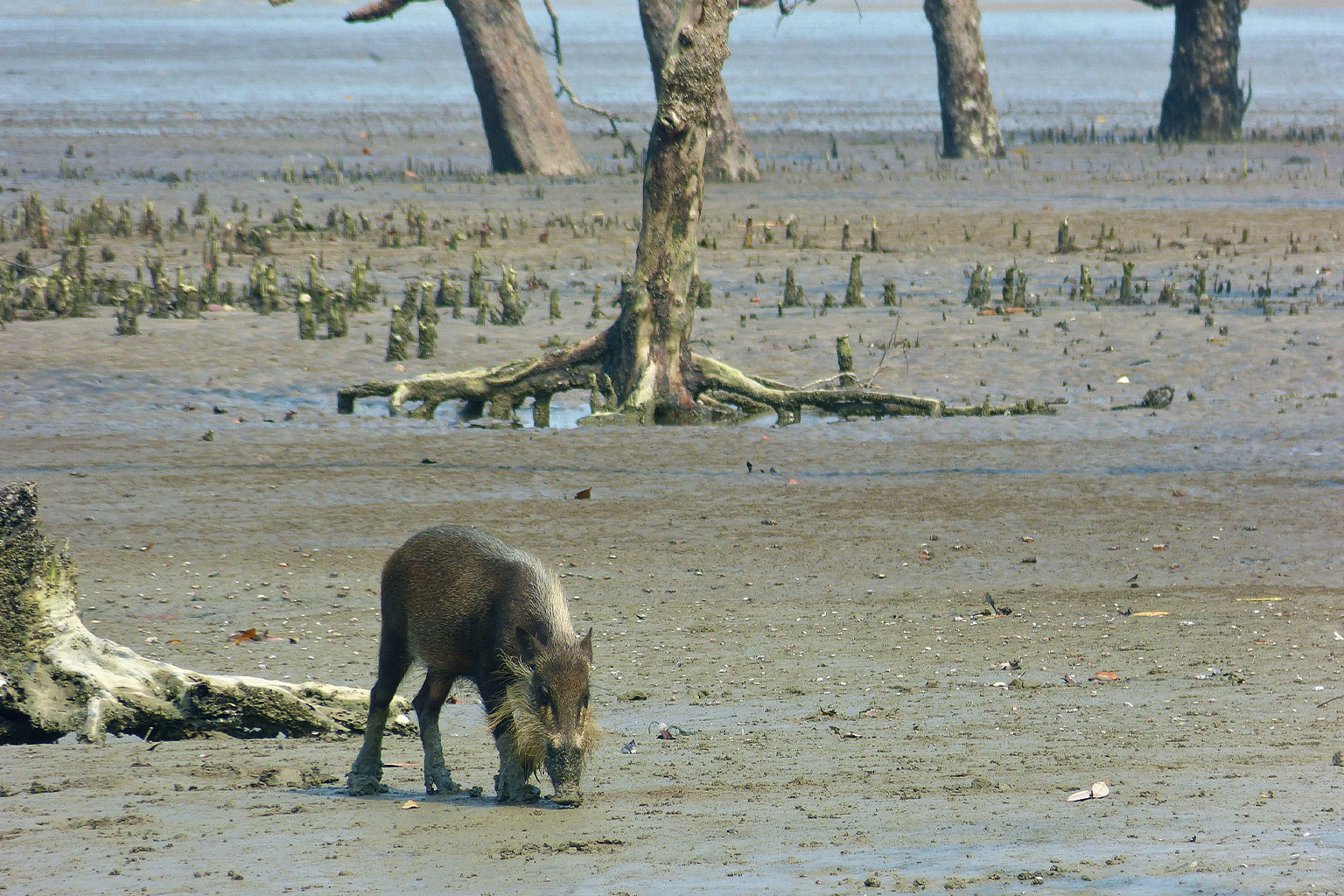- A recent study examined the impacts of ecological and sociocultural influences on bearded pig populations in Malaysian Borneo.
- The researchers found that the presence of pigs is “compatible” with Indigenous hunting in certain areas.
- The team’s findings point to the importance of a nuanced understanding of nearby human cultural values and local ecology in determining policies toward hunting.
Bearded pigs play a prominent role in the lives of many people living on the island of Borneo. For some ethnic groups, they’re a hunter’s most-prized quarry, providing an important source of protein, and a shared pig is often a central part of community celebrations.
Now, a recent study provides quantitative evidence for the first time that Bornean bearded pigs (Sus barbatus) can persist even in areas where they’re highly sought-after by local Indigenous groups.
“For thousands of years, the bearded pig has been hunted,” said David Kurz, a conservation scientist and postdoctoral fellow at Trinity College in the U.S. and the lead author of the study published Feb. 17 in the journal npj Biodiversity. “We know that from archaeological evidence.”
Prior research has also shown that hunting affects the movements of bearded pigs and the areas they frequent. Kurz and his colleagues wanted to know whether the pig’s presence could be tied to specific social and cultural factors in the areas where they occur.

The team began with camera trap-recorded detections of bearded pigs from 18 field sites in the Malaysian states of Sabah and Sarawak on the island of Borneo collected between 2010 and 2014. In their analysis, they examined how certain variables might determine whether pigs were present in specific areas. For example, they included ecological factors, such as a location’s proximity to water or the edge of the forest, as well as “socio-cultural variables,” like whether the humans living nearby had a tradition of hunting pigs, and how accessible the terrain was for hunters.
Muslims in Malaysia, as elsewhere, generally don’t eat pork. But many members of Borneo’s large Indigenous minorities, such as the Kadazandusun-Murut in Sabah and the Iban in Sarawak, practice Christianity and hold bearded pig meat in high regard. Kurz’s earlier research sought to understand how pig hunting had changed in these societies with changes to the island, like the influx of oil palm plantations over recent years.
“We heard people say things like, ‘I live in the forest. This is my food,’” Kurz said. “We really saw the importance of the bearded pig in dietary and cultural terms.” Because of its role in some groups’ lives and the impact that social practices have on its presence, the team dubbed the bearded pig “a cultural keystone species.”
The team aimed to integrate those social variables along with what they knew about the pig’s ecology to produce more nuanced maps showing where the occurrence of pigs was most likely.
Their findings suggested a strong relationship between the culture of the people living nearby and the number of pigs. Pigs were likely to be more numerous in easily accessible areas where fewer of the nearby humans were from pig-hunting cultures, such as places in Malaysian Borneo where Islam predominates. They also found high probabilities of finding pigs near pig-hunting cultures in areas that were difficult for hunters to reach, such as those far from roads or cities.
Peter Williams, a postdoctoral researcher and ecologist at Michigan State University in the U.S., who wasn’t involved in the research, said the study demonstrates “the importance of considering culture and how humans are affecting wildlife.”
That’s not to say hunting isn’t a concern, Kurz said, especially when hunting moves beyond the subsistence level and starts to supply commercial markets.
“Hunting in tropical forests, especially in Southeast Asia, is a big conservation threat,” he said. “I don’t want to sugarcoat that.”
Still, the study demonstrates the possible coexistence of Indigenous hunting and the sustained presence of bearded pigs.
“In essence, that is showing something that Indigenous communities have known for thousands of years,” Kurz said, “which is that there’s potential compatibility between Indigenous environmental stewardship and ecological sustainability.”
The authors say that managing bearded pig populations requires an inclusive process with a diversity of voices from different parts of society. But their data do suggest that restrictions on hunting in readily accessible areas near pig-hunting groups are likely more important than, say, limits on hunting in inaccessible areas with pig-hunting groups nearby. Restrictions on hunting when the nearby human population doesn’t place a high cultural value on bearded pigs also aren’t as critical.

A ‘baseline’ for recovery?
Recently, Malaysian Borneo’s bearded pigs have had to contend with African swine fever. It’s not clear how much this virulent disease has affected pig numbers, but studies have found that fatality rates range from about 50% to 100% (but only for pigs — the disease doesn’t affect the humans who eat the meat). Bearded pigs are probably nowhere near as numerous as they were in the early 2010s when the scientists collected the data for this study, the authors write.
Their findings do provide a “baseline” against which the bearded pig’s recovery can be measured, Kurz said — at least since humans have altered the animal’s habitat with logging, oil palm agriculture and the expansion of urban areas over the past several decades.
“It’s an imperfect target, but it does give us some kind of number,” Kurz said.
Even before swine fever hit, the Bornean bearded pig was considered vulnerable on the IUCN Red List. Bearded pigs’ swift reproductive rates could help them recover, Kurz added: A single sow can have multiple litters of 12 or more piglets a year in the right conditions. But whether bearded pig numbers can withstand continued hunting is an open question. To reach sustainable levels, the authors call for the inclusion of Indigenous leaders in wildlife management decisions, taking into account the culture and traditions of local human groups.
“Conservation has shown us that if you don’t include local communities, then you’re unlikely to have long-term sustainable solutions,” Kurz added. “It’s both more ethical and more effective to consider long-term needs of human communities alongside long-term needs of ecological communities, and often there are compatible links that promote both.”
Banner image: A Bornean bearded pig family in Bako National Park, Sarawak, Borneo. Image by Carine06 via Flickr (CC BY-SA 2.0).
John Cannon is a staff features writer with Mongabay. Find him on Twitter: @johnccannon
Borneo’s bearded pigs and traditional hunters adapted to oil palms. Then came swine fever
Citations:
Kurz, D. J., Connor, T., Brodie, J. F., Baking, E. L., Szeto, S. H., Hearn, A. J., … Brashares, J. S. (2023). Socio-ecological factors shape the distribution of a cultural Keystone species in Malaysian Borneo. npj Biodiversity, 2(1). doi:10.1038/s44185-022-00008-w
Kurz, D. J., Saikim, F. H., Justine, V. T., Bloem, J., Libassi, M., Luskin, M. S., … Potts, M. D. (2021). Transformation and endurance of Indigenous hunting: Kadazandusun‐Murut bearded pig hunting practices amidst oil palm expansion and urbanization in Sabah, Malaysia. People and Nature, 3(5), 1078-1092. doi:10.1002/pan3.10250
Luskin, M. S., Meijaard, E., Surya, S., Sheherazade, Walzer, C., & Linkie, M. (2020). African swine fever threatens Southeast Asia’s 11 endemic wild pig species. Conservation Letters. doi:10.1111/conl.12784
FEEDBACK: Use this form to send a message to the author of this post. If you want to post a public comment, you can do that at the bottom of the page.
This story first appeared on Mongabay
South Africa Today – Environment
This article is licensed under a Creative Commons Attribution-NoDerivatives 4.0 International License.
You may republish this article, so long as you credit the authors and Mongabay, and do not change the text. Please include a link back to the original article.












